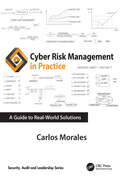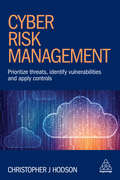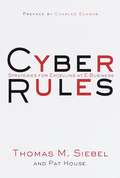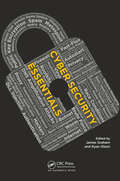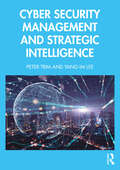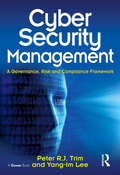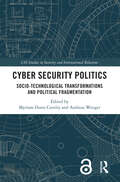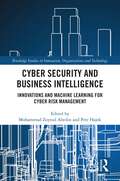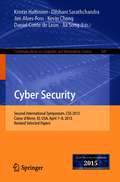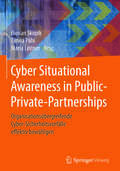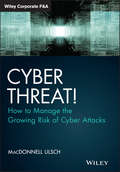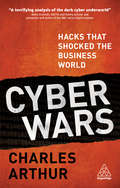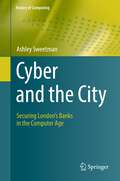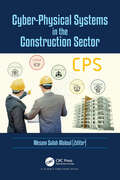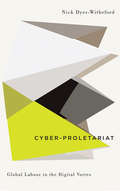- Table View
- List View
Cyber Risk Management in Practice: A Guide to Real-World Solutions (Security, Audit and Leadership Series)
by Carlos MoralesCyber Risk Management in Practice: A Guide to Real-World Solutions is your companion in the ever-changing landscape of cybersecurity. Whether you're expanding your knowledge or looking to sharpen your existing skills, this book demystifies the complexities of cyber risk management, offering clear, actionable strategies to enhance your organization's security posture. With a focus on real-world solutions, this guide balances practical application with foundational knowledge.Key Features: Foundational Insights: Explore fundamental concepts, frameworks, and required skills that form the backbone of a strong and pragmatic cyber risk management program tailored to your organization’s unique needs. It covers everything from basic principles and threat modeling to developing a security-first culture that drives change within your organization. You’ll also learn how to align cybersecurity practices with business objectives to ensure a solid approach to risk management. Practical Application: Follow a hands-on step-by-step implementation guide through the complete cyber risk management cycle, from business context analysis to developing and implementing effective treatment strategies. This book includes templates, checklists, and practical advice to execute your cyber risk management implementation, making complex processes manageable and straightforward. Real-world scenarios illustrate common pitfalls and effective solutions. Advanced Strategies: Go beyond the basics to achieve cyber resilience. Explore topics like third-party risk management, integrating cybersecurity with business continuity, and managing the risks of emerging technologies like AI and quantum computing. Learn how to build a proactive defense strategy that evolves with emerging threats and keeps your organization secure. “Cyber Risk Management in Practice: A Guide to Real-World Solutions by Carlos Morales serves as a beacon for professionals involved not only in IT or cybersecurity but across executive and operational roles within organizations. This book is an invaluable resource that I highly recommend for its practical insights and clear guidance” – José Antonio Fernández Carbajal. Executive Chairman and CEO of FEMSA
Cyber Risk Management: Prioritize Threats, Identify Vulnerabilities and Apply Controls
by Christopher HodsonMost organizations are undergoing a digital transformation of some sort and are looking to embrace innovative technology, but new ways of doing business inevitably lead to new threats which can cause irreparable financial, operational and reputational damage. In an increasingly punitive regulatory climate, organizations are also under pressure to be more accountable and compliant. Cyber Risk Management clearly explains the importance of implementing a cyber security strategy and provides practical guidance for those responsible for managing threat events, vulnerabilities and controls, including malware, data leakage, insider threat and Denial-of-Service. Examples and use cases including Yahoo, Facebook and TalkTalk, add context throughout and emphasize the importance of communicating security and risk effectively, while implementation review checklists bring together key points at the end of each chapter. Cyber Risk Management analyzes the innate human factors around risk and how they affect cyber awareness and employee training, along with the need to assess the risks posed by third parties. Including an introduction to threat modelling, this book presents a data-centric approach to cyber risk management based on business impact assessments, data classification, data flow modelling and assessing return on investment. It covers pressing developments in artificial intelligence, machine learning, big data and cloud mobility, and includes advice on responding to risks which are applicable for the environment and not just based on media sensationalism.
Cyber Risk Management: Prioritize Threats, Identify Vulnerabilities and Apply Controls
by Christopher J HodsonHow can you manage the complex threats that can cause financial, operational and reputational damage to the business? This practical guide shows how to implement a successful cyber security programme. The second edition of Cyber Risk Management covers the latest developments in cyber security for those responsible for managing threat events, vulnerabilities and controls. These include the impact of Web3 and the metaverse on cyber security, supply-chain security in the gig economy and exploration of the global, macroeconomic conditions that affect strategies. It explains how COVID-19 and remote working changed the cybersecurity landscape.Cyber Risk Management presents a data-centric approach to cyber risk management based on business impact assessments, data classification, data flow modelling and assessing return on investment. It covers pressing developments in artificial intelligence, machine learning, big data and cloud mobility, and includes advice on dealing with malware, data leakage, insider threat and Denial-of-Service. With analysis on the innate human factors affecting cyber risk and awareness and the importance of communicating security effectively, this book is essential reading for all risk and cybersecurity professionals.
Cyber Risks for Business Professionals
by Rupert KendrickRealise the benefits of Internet technologies, while ensuring your company is protected from the associated risks!An effective risk management strategy is vital to your company's survival Internet technologies have revolutionised the way that business is conducted. However, these innovations expose your business to various risks. Inadequate security can lead to the theft of customer data and, in the event of technological failure or a cyberattack, your business could lose its ability to function altogether. An effective risk management strategy is, therefore, vital to your company's survival. Understand the origins of cyber risks and develop suitable strategies for their management Cyber Risks for Business Professionals: A Management Guide is a general guide to the origins of cyber risks and to developing suitable strategies for their management. It provides a breakdown of the main risks involved and shows you how to manage them. Covering the relevant legislation on information security and data protection, the author combines his legal expertise with a solid, practical grasp of the latest developments in IT to offer a comprehensive overview of a highly complex subject. Expert guidance examining the operational and technological risks Drawing on interviews with experts from Clifford Chance, Capgemini and Morgan Stanley amongst others, the book examines the operational and technological risks alongside the legal and compliance issues. This book will be invaluable to lawyers and accountants, as well as to company directors and business professionals. Benefits to business include: * Understand and manage the technological risks This book looks at the security issues surrounding Cloud computing, and highlights the problems that have arisen as a result of the use of laptop computers and memory sticks for remote working. Implementing a risk management framework will offer reassurance to your existing customers and improve your chances of winning new business. * Familiarise yourself with the legal issues You need to be aware of the laws that govern your activities when you do business online. The author offers you a guide to the most important aspects of IT law, and outlines the implications of recent legislation. The author also looks at the compliance requirements of PCI DSS (the Payment Card Industry Data Security Standard). * Control employee use of Web 2. 0 technologies While sites such as Facebook and LinkedIn help people to develop business contacts, employee misuse of social networking sites also causes problems, ranging from damage to the company's reputation to breaches of commercial confidentiality. This book offers advice on the right policy to adopt to ensure your staff use Web 2. 0 technologies responsibly. * Use technology to address the risks This book introduces you to IT solutions that you can deploy to improve your information security, such as encryption and digital watermarking. It also looks at how you can monitor and control e-mail to prevent the leaking of sensitive information.
Cyber Rules: Strategies for Excelling at E-Business
by Thomas M. Siebel Pat HouseThe book is about the dos and don'ts when doing the business through the Internet. It also has an overview of how the Internet opens new possibilities for business, in a nontechnical language.
Cyber Security Essentials
by Richard Howard James Graham Ryan OlsonThe sophisticated methods used in recent high-profile cyber incidents have driven many to need to understand how such security issues work. Demystifying the complexity often associated with information assurance, Cyber Security Essentials provides a clear understanding of the concepts behind prevalent threats, tactics, and procedures.To accomplish
Cyber Security Foundations: Fundamentals, Technology and Society
by Keith Martin Konstantinos Mersinas Guido Schmitz Jassim HappaCyber Security Foundations introduces the core topics that all cyber security students and future professionals need to understand the cyber security landscape. It is a key textbook for postgraduate and undergraduate students taking modules related to cyber security and information security, as well as for general readers seeking to deepen their understanding of technical and human-centred digital security concepts.Features include:- Chapters on core areas such as cryptography, computer security, cyber security management, cybercrime and privacy, informed by the CyBOK knowledge areas- Demonstration of how the many facets of the discipline interrelate, allowing readers to gain a comprehensive understanding of the cyber security landscape- Real-world examples to illustrate the application of ideas- Learning outcomes and activities to help reinforce learning and exploration beyond the core text, and a glossary to equip readers with the language necessary to make sense of each topic
Cyber Security Management and Strategic Intelligence
by Peter Trim Yang-Im LeeWithin the organization, the cyber security manager fulfils an important and policy-oriented role. Working alongside the risk manager, the Information Technology (IT) manager, the security manager and others, the cyber security manager’s role is to ensure that intelligence and security manifest in a robust cyber security awareness programme and set of security initiatives that when implemented help strengthen the organization’s defences and those also of its supply chain partners.Cyber Security Management and Strategic Intelligence emphasizes the ways in which intelligence work can be enhanced and utilized, guiding the reader on how to deal with a range of cyber threats and strategic issues. Throughout the book, the role of the cyber security manager is central, and the work undertaken is placed in context with that undertaken by other important staff, all of whom deal with aspects of risk and need to coordinate the organization’s defences thus ensuring that a collectivist approach to cyber security management materializes. Real-world examples and cases highlight the nature and form that cyber-attacks may take, and reference to the growing complexity of the situation is made clear. In addition, various initiatives are outlined that can be developed further to make the organization less vulnerable to attack. Drawing on theory and practice, the authors outline proactive, and collectivist approaches to counteracting cyber-attacks that will enable organizations to put in place more resilient cyber security management systems, frameworks and planning processes.Cyber Security Management and Strategic Intelligence references the policies, systems and procedures that will enable advanced undergraduate and postgraduate students, researchers and reflective practitioners to understand the complexity associated with cyber security management and apply a strategic intelligence perspective. It will help the cyber security manager to promote cyber security awareness to a number of stakeholders and turn cyber security management initiatives into actionable policies of a proactive nature.
Cyber Security Management: A Governance, Risk and Compliance Framework
by Peter Trim Yang-Im LeeCyber Security Management: A Governance, Risk and Compliance Framework by Peter Trim and Yang-Im Lee has been written for a wide audience. Derived from research, it places security management in a holistic context and outlines how the strategic marketing approach can be used to underpin cyber security in partnership arrangements. The book is unique because it integrates material that is of a highly specialized nature but which can be interpreted by those with a non-specialist background in the area. Indeed, those with a limited knowledge of cyber security will be able to develop a comprehensive understanding of the subject and will be guided into devising and implementing relevant policy, systems and procedures that make the organization better able to withstand the increasingly sophisticated forms of cyber attack. The book includes a sequence-of-events model; an organizational governance framework; a business continuity management planning framework; a multi-cultural communication model; a cyber security management model and strategic management framework; an integrated governance mechanism; an integrated resilience management model; an integrated management model and system; a communication risk management strategy; and recommendations for counteracting a range of cyber threats. Cyber Security Management: A Governance, Risk and Compliance Framework simplifies complex material and provides a multi-disciplinary perspective and an explanation and interpretation of how managers can manage cyber threats in a pro-active manner and work towards counteracting cyber threats both now and in the future.
Cyber Security Politics: Socio-Technological Transformations and Political Fragmentation (CSS Studies in Security and International Relations)
by Myriam Dunn Cavelty and Andreas WengerThis book examines new and challenging political aspects of cyber security and presents it as an issue defined by socio-technological uncertainty and political fragmentation. Structured along two broad themes and providing empirical examples for how socio-technical changes and political responses interact, the first part of the book looks at the current use of cyber space in conflictual settings, while the second focuses on political responses by state and non-state actors in an environment defined by uncertainties. Within this, it highlights four key debates that encapsulate the complexities and paradoxes of cyber security politics from a Western perspective – how much political influence states can achieve via cyber operations and what context factors condition the (limited) strategic utility of such operations; the role of emerging digital technologies and how the dynamics of the tech innovation process reinforce the fragmentation of the governance space; how states attempt to uphold stability in cyberspace and, more generally, in their strategic relations; and how the shared responsibility of state, economy, and society for cyber security continues to be re-negotiated in an increasingly trans-sectoral and transnational governance space. This book will be of much interest to students of cyber security, global governance, technology studies, and international relations.
Cyber Security and Business Intelligence: Innovations and Machine Learning for Cyber Risk Management (Routledge Studies in Innovation, Organizations and Technology)
by Petr Hajek Mohammad Zoynul AbedinTo cope with the competitive worldwide marketplace, organizations rely on business intelligence to an increasing extent. Cyber security is an inevitable practice to protect the entire business sector and its customer. This book presents the significance and application of cyber security for safeguarding organizations, individuals’ personal information, and government. The book provides both practical and managerial implications of cyber security that also supports business intelligence and discusses the latest innovations in cyber security. It offers a roadmap to master degree students and PhD researchers for cyber security analysis in order to minimize the cyber security risk and protect customers from cyber-attack. The book also introduces the most advanced and novel machine learning techniques including, but not limited to, Support Vector Machine, Neural Networks, Extreme Learning Machine, Ensemble Learning, and Deep Learning Approaches, with a goal to apply those to cyber risk management datasets. It will also leverage real-world financial instances to practise business product modelling and data analysis. The contents of this book will be useful for a wide audience who are involved in managing network systems, data security, data forecasting, cyber risk modelling, fraudulent credit risk detection, portfolio management, and data regulatory bodies. It will be particularly beneficial to academics as well as practitioners who are looking to protect their IT system, and reduce data breaches and cyber-attack vulnerabilities.
Cyber Security and Business Intelligence: Innovations and Machine Learning for Cyber Risk Management (Routledge Studies in Innovation, Organizations and Technology)
by Petr Hajek Mohammad Zoynul AbedinTo cope with the competitive worldwide marketplace, organizations rely on business intelligence to an increasing extent. Cyber security is an inevitable practice to protect the entire business sector and its customer. This book presents the significance and application of cyber security for safeguarding organizations, individuals’ personal information, and government.The book provides both practical and managerial implications of cyber security that also supports business intelligence and discusses the latest innovations in cyber security. It offers a roadmap to master degree students and PhD researchers for cyber security analysis in order to minimize the cyber security risk and protect customers from cyber-attack. The book also introduces the most advanced and novel machine learning techniques including, but not limited to, Support Vector Machine, Neural Networks, Extreme Learning Machine, Ensemble Learning, and Deep Learning Approaches, with a goal to apply those to cyber risk management datasets. It will also leverage real-world financial instances to practise business product modelling and data analysis.The contents of this book will be useful for a wide audience who are involved in managing network systems, data security, data forecasting, cyber risk modelling, fraudulent credit risk detection, portfolio management, and data regulatory bodies. It will be particularly beneficial to academics as well as practitioners who are looking to protect their IT system, and reduce data breaches and cyber-attack vulnerabilities.
Cyber Security and Operations Management for Industry 4.0
by Ahmed A ElngarThis book seamlessly connects the topics of Industry 4.0 and cyber security. It discusses the risks and solutions of using cyber security techniques for Industry 4.0.Cyber Security and Operations Management for Industry 4.0 covers the cyber security risks involved in the integration of Industry 4.0 into businesses and highlights the issues and solutions. The book offers the latest theoretical and practical research in the management of cyber security issues common in Industry 4.0 and also discusses the ethical and legal perspectives of incorporating cyber security techniques and applications into the day-to-day functions of an organization. Industrial management topics related to smart factories, operations research, and value chains are also discussed.This book is ideal for industry professionals, researchers, and those in academia who are interested in learning more about how cyber security and Industry 4.0 are related and can work together.
Cyber Security. Simply. Make it Happen.: Leveraging Digitization Through IT Security (Management for Professionals)
by Ferri AbolhassanThis book provides a practical and strategic perspective on IT and cyber security for corporations and other businesses. Leading experts from industry, politics and research discuss the status quo and future prospects of corporate cyber security. They answer questions such as: How much will IT security cost? Who will provide IT security? Can security even be fun? The book claims that digitization will increasingly pervade all areas of the economy, as well as our daily professional and personal lives. It will produce speed, agility and cost efficiency, but also increasing vulnerability in the context of public, corporate and private life. Consequently, cyber security is destined to become the great facilitator of digitization, providing maximum protection for data, networks, data centres and terminal devices.
Cyber Security: Power and Technology (Intelligent Systems, Control and Automation: Science and Engineering #93)
by Pekka Neittaanmäki Martti LehtoThis book gathers the latest research results of scientists from different countries who have made essential contributions to the novel analysis of cyber security. Addressing open problems in the cyber world, the book consists of two parts. Part I focuses on cyber operations as a new tool in global security policy, while Part II focuses on new cyber security technologies when building cyber power capabilities. The topics discussed include strategic perspectives on cyber security and cyber warfare, cyber security implementation, strategic communication, trusted computing, password cracking, systems security and network security among others.
Cyber Security: Second International Symposium, CSS 2015, Coeur d'Alene, ID, USA, April 7-8, 2015, Revised Selected Papers (Communications in Computer and Information Science #589)
by Kristin Haltinner Dilshani Sarathchandra Jim Alves-Foss Kevin Chang Daniel Conte de Leon Jia SongThis book constitutes the refereed proceedings of the Second International Symposium on Cyber Security, CSS 2015, held in Coeur d'Alene, ID, USA, in April 2015. The 9 revised full papers presented were carefully reviewed and selected from 20 papers. The papers reflect four areas of scholarly work: permissions and trust evaluation, implementation and management; cloud and device security and privacy; social implications of networked and mobile applications; system and process assessments for improved cybersecurity.
Cyber Situational Awareness in Public-Private-Partnerships: Organisationsübergreifende Cyber-Sicherheitsvorfälle effektiv bewältigen
by Florian Skopik Maria Leitner Tímea PáhiDigitale Dienste werden für unsere Gesellschaft immer wichtiger, daher gelangen sie auch stärker ins Visier von Wirtschaftskriminellen, Spionen, Terroristen oder staatsfeindlichen Gruppierungen. Wie schützen sich Unternehmen und Staaten vor solchen Cyber-Attacken? Ein wichtiger Grundstein ist die Schaffung von Behörden, wie sie die EU-Richtlinie über Maßnahmen zur Gewährleistung eines hohen gemeinsamen Sicherheitsniveaus von Netz- und Informationssystemen (NIS) vorsieht. Das Buch zeigt, wie sich die Zusammenarbeit von Unternehmen mit diesen NIS-Behörden gestaltet mit dem gemeinsamen Ziel, Cyber-Sicherheit zu etablieren und zu gewährleisten. Darüber hinaus legen die Autoren dar, wie sich die NIS-Richtlinie und die im Mai 2018 in Kraft getretene EU-Datenschutz-Grundverordnung (DSGVO) auf Security-Prozesse in Unternehmen auswirken können. Das Buch verknüpft technische, organisatorische und rechtliche Aspekte der Zusammenarbeit und spiegelt damit die Komplexität des Themas wider. Zugleich liefert es zahlreiche Vorschläge zur Umsetzung der EU-Richtlinie. Im Mittelpunkt steht dabei das Konzept der „Cyber Situational Awareness“ – das bewusste Erfassen der aktuellen Lage – und damit ein Instrument, mit dem sich die Reaktionsfähigkeit bei Cyber-Angriffen wesentlich erhöhen lässt. Folgende Themen werden erläutert: • Aufbau und Nutzung von Cyber Situational Awareness • Erstellung von Cyber-Lagebildern auf nationaler Ebene • Informations- und Datenquellen für Cyber-Lagebilder• Informationsaustausch zwischen Cyber-Lagezentren und Stakeholdern • Informations- und Meldepflichten von Unternehmen• Planspiel zur Bildung und Evaluierung von Cyber Situational Awareness
Cyber Threat!: How to Manage the Growing Risk of Cyber Attacks (Wiley Corporate F&A)
by MacDonnell UlschConquering cyber attacks requires a multi-sector, multi-modal approach Cyber Threat! How to Manage the Growing Risk of Cyber Attacks is an in-depth examination of the very real cyber security risks facing all facets of government and industry, and the various factors that must align to maintain information integrity. Written by one of the nation's most highly respected cyber risk analysts, the book describes how businesses and government agencies must protect their most valuable assets to avoid potentially catastrophic consequences. Much more than just cyber security, the necessary solutions require government and industry to work cooperatively and intelligently. This resource reveals the extent of the problem, and provides a plan to change course and better manage and protect critical information. Recent news surrounding cyber hacking operations show how intellectual property theft is now a matter of national security, as well as economic and commercial security. Consequences are far-reaching, and can have enormous effects on national economies and international relations. Aggressive cyber forces in China, Russia, Eastern Europe and elsewhere, the rise of global organized criminal networks, and inattention to vulnerabilities throughout critical infrastructures converge to represent an abundantly clear threat. Managing the threat and keeping information safe is now a top priority for global businesses and government agencies. Cyber Threat! breaks the issue down into real terms, and proposes an approach to effective defense. Topics include: The information at risk The true extent of the threat The potential consequences across sectors The multifaceted approach to defense The growing cyber threat is fundamentally changing the nation's economic, diplomatic, military, and intelligence operations, and will extend into future technological, scientific, and geopolitical influence. The only effective solution will be expansive and complex, encompassing every facet of government and industry. Cyber Threat! details the situation at hand, and provides the information that can help keep the nation safe.
Cyber Wars: Hacks that Shocked the Business World
by Charles ArthurCyber Wars gives you the dramatic inside stories of some of the world's biggest cyber attacks. These are the game changing hacks that make organizations around the world tremble and leaders stop and consider just how safe they really are. Charles Arthur provides a gripping account of why each hack happened, what techniques were used, what the consequences were and how they could have been prevented. Cyber attacks are some of the most frightening threats currently facing business leaders and this book provides a deep insight into understanding how they work, how hackers think as well as giving invaluable advice on staying vigilant and avoiding the security mistakes and oversights that can lead to downfall. No organization is safe but by understanding the context within which we now live and what the hacks of the future might look like, you can minimize the threat. In Cyber Wars, you will learn how hackers in a TK Maxx parking lot managed to steal 94m credit card details costing the organization $1bn; how a 17 year old leaked the data of 157,000 TalkTalk customers causing a reputational disaster; how Mirai can infect companies' Internet of Things devices and let hackers control them; how a sophisticated malware attack on Sony caused corporate embarrassment and company-wide shut down; and how a phishing attack on Clinton Campaign Chairman John Podesta's email affected the outcome of the 2016 US election.
Cyber and the City: Securing London’s Banks in the Computer Age (History of Computing)
by Ashley SweetmanCyber security is the greatest risk faced by financial institutions today, a risk they have understood and managed for decades longer than is commonly understood. Ever since the major London banks purchased their first computers in the early 1960s, they have had to balance their dependence on those machines with the need to secure their operations and retain the trust of their customers. Technological change in the second half of the 20th century prompted British banks to reevaluate their function as trusted protectors of wealth. In the City of London, the capital’s oldest area and historically its business and commerce hub, the colossal clearing banks employed newly commercialised electronic computers—the processing power of which could transform the highly clerical clearing and settlement process. What unfolded over the following three decades was a relentless modernisation drive. Revolutionising the way that banks and other financial institutions conducted business and interacted with each other and permanently altering the speed and scale at which the United Kingdom’s financial sector functioned, this rapid modernisation thrust computer security into the consciousness of bank executives and their clients alike. Dependence on computers quickly grew, and the banks immediately realised the need to secure their new software and hardware. Focusing on the period 1960 to 1990, this book uses newly released and previously unexplored archival material to trace the origins of cyber security in the UK financial sector. Topics and features: Describes how institutions managed the evolving challenge of computer security in the second half of the 20th century Demonstrates continuity in banks' views of security through the prism of confidentiality, integrity and availability, and the concept of resilience Presents case studies of bank collaboration on computer security through creation of payment systems like SWIFT and CHAPS Outlines the shift from focusing on physical security measures to technical network-protection measures Explores the relationship between banks and the UK Government as bank operations became dependent on computer and network technology This work will be of value to students and academic researchers in the history of computing, financial history, and the history of intelligence and security, as well as the general reader interested in contemporary intelligence, cyber security, and finance.
Cyber-Physical Microgrids
by Yan LiThis textbook provides students with an overview of cyber-physical microgrid networks and an in-depth introduction to photovoltaics, batteries, flywheel, supercapacitor, micro-turbines, wind generation, power-electronic interfaces, modeling and stability analysis of microgrids, and cyber-communication networks and security. The text helps upper-level undergraduate and graduate students gain a foundational understanding of microgrids and renewable energy, and offers an introduction to the frontier of theoretical research and practical applications of cyber-physical systems, paving the way to uncover and understand the operational mechanism of cyber-physical microgrids. The book includes examples and test systems throughout for problem-solving and will be an essential resource for students, researchers, and professionals in power engineering.
Cyber-Physical Systems in the Construction Sector
by Wesam Salah AlaloulCyber-Physical Systems (CPSs) are mechanisms for monitoring and controlling processes using computer-based algorithms. In the construction industry, CPSs help to increase the viability of construction projects by reducing costs, time and management effort. This book aims to develop the fundamental concepts of construction project management associated with the CPSs and their applications within the modern construction industry in alignment with the scope of the Fourth Industrial Revolution (IR4.0). The book has been structured in a systematic way for easy understanding by construction industry researchers and academic faculty. The first part of the book helps readers to develop a basic understanding of the fundamental concepts of construction project management and CPSs. Followed by the second part about the CPSs implementation framework and understanding the operational concepts associated with the notion of IoT and Digital Twins within the construction industry. The third part of the book describes modelling/simulation techniques to develop the customised CPSs for construction project management. The concluding part provides an in-depth review of applications of CPSs, associated threats and security.
Cyber-Proletariat: Global Labour in the Digital Vortex
by Nick Dyer-WithefordThe utopian promise of the internet, much talked about even a few years ago, has given way to brutal realities: coltan mines in the Congo, electronics factories in China, devastated neighborhoods in Detroit. Cyber-Proletariat shows us the dark-side of the information revolution through an unsparing analysis of class power and computerization. Dyer-Witheford investigates how technology facilitates growing polarization between wealthy elites and precarious workers. He reveals the class domination behind everything from expanding online surveillance to intensifying robotization. At the same time, he looks at possibilities for information technology within radical movements.
CyberArk: Protecting the Keys to the IT Kingdom
by David B. Yoffie Raffaella Sadun Margot EiranCyberArk was the recognized leader in the Privileged Account Management (PAM) space, a cybersecurity sub-segment it had essentially created to secure organizations’ IT systems and sensitive data. Over 17 years the Israeli company had grown to a market capitalization of over $1.6 billion, with sales exceeding $217 million, and 900 global employees with a strong corporate culture. In May 2017, Udi Mokady, Founder, Chairman and CEO, debated how best to drive growth. He mulled over whether he should stay the course and remain focused on providing best of breed PAM for enterprises, both on-premise and in the cloud, or expand into new markets. Cyber threats were on the rise, which afforded numerous growth opportunities such as entering the broader identity management space, creating new products to protect critical infrastructure, and securing the burgeoning world of the Internet of Things (IoT). This case explores the company's competitive position, the challenges of sustaining its advantages in a highly competitive and consolidating industry, and whether it should pursue organic or inorganic growth, while maintaining company culture.
CyberArk: Protecting the Keys to the IT Kingdom
by David B. Yoffie Raffaella Sadun Margot EiranCyberArk was the recognized leader in the Privileged Account Management (PAM) space, a cybersecurity sub-segment it had essentially created to secure organizations' IT systems and sensitive data. Over 17 years the Israeli company had grown to a market capitalization of over $1.6 billion, with sales exceeding $217 million, and 900 global employees with a strong corporate culture. In May 2017, Udi Mokady, Founder, Chairman and CEO, debated how best to drive growth. He mulled over whether he should stay the course and remain focused on providing best of breed PAM for enterprises, both on-premise and in the cloud, or expand into new markets. Cyber threats were on the rise, which afforded numerous growth opportunities such as entering the broader identity management space, creating new products to protect critical infrastructure, and securing the burgeoning world of the Internet of Things (IoT). This case explores the company's competitive position, the challenges of sustaining its advantages in a highly competitive and consolidating industry, and whether it should pursue organic or inorganic growth, while maintaining company culture.
